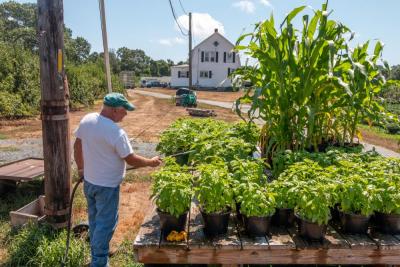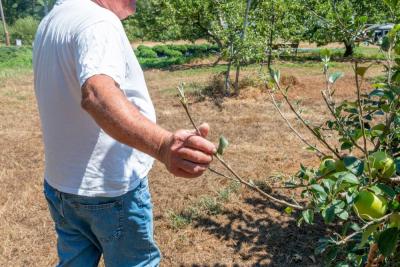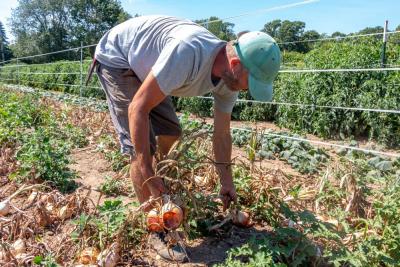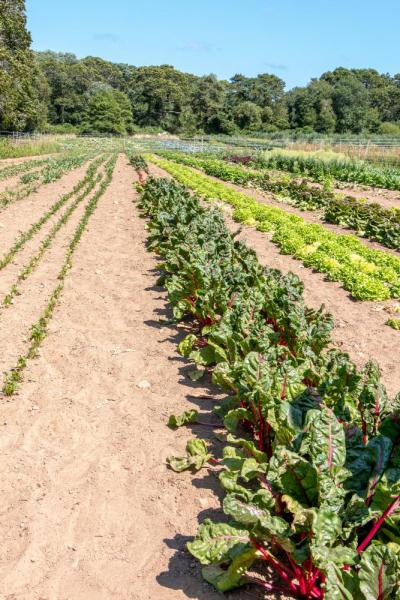“Our own little dust bowl”: Farmers cope with severe drought

The South Coast is experiencing a severe drought and while many residents are being confronted with high temperatures and dying lawns, Dartmouth’s farmers are feeling the effects in even more damaging ways.
“It’s been really tough,” said Susan Murray of Flying Carrot Farms, citing a “cascading effect” of high temperatures and a lack of rain.
According to data from a weather station at New Bedford Regional Airport provided by the National Weather Service, July’s rainfall totaled just .14 inches — the lowest monthly total recorded at the station in over 20 years.
At the same time, July’s daily high temperature averaged 86.1 degrees, the highest since 2011.
The weather has caused top soil to dry into a fine dust that is difficult to work with and inhospitable for planting.
“I’m trying to turn beds over to get ready for fall crops and it’s just blowing away,” Murray said. “It’s like our own little dust bowl.”
Water woes
To combat the extreme conditions, many farmers have set up irrigation systems which can be expensive and labor intensive to install.
They also bring with them the challenge of sourcing the water as the systems can draw thousands of gallons a day.
Most farms get their water from wells, the cheapest option as there is no cost for the water itself. But wells create challenges of their own, because they can run dry if used too heavily, especially when groundwater is not being replenished by rain.
“We’re very limited on water we can take out of the well,” said Murray, explaining that at some of her farm sites, they have to share a well with other farmers.
She said that she and her husband, Tony Wood, decided to move all their chickens to their Elm Street farm because it is connected to town water, providing an ample supply.
But town water can be expensive in the quantities needed for agriculture, especially after town officials recently announced a rate hike.
“So yes, we have good water,” Murray said. “But we don’t go crazy with it because we’re paying for it.”
Some farmers have no choice, though.
Brian Medeiros, owner of Dartmouth Orchards on Old Westport Road, said he has a well on his property, but it is only 18 feet deep and dried up years ago after the town placed its own much deeper well nearby.
As a result, Medeiros has been forced to pump water from a nearby fire hydrant into large tanks that he pulls with his tractor through the orchard, a daily chore that is both costly and labor-intensive.
“It takes its toll because trees need a lot of water,” he said.
Medeiros estimated that he has already used over 75,000 gallons of water this year to nourish his fruit trees, some of which were planted by his grandfather nearly a century ago.
“I’ve got over 2,000 fruit trees,” he said. “You can’t water everything.”
And if watering wasn’t enough to contend with, farmers have already begun to see the indirect effects of the drought wreak havoc on their crops.
A feast for fauna
Anyone with a lawn or garden knows that the drought has not stopped at wilting crops and parching fruit trees.
Plants of all varieties have been stunted and scorched by the extreme weather, leaving Dartmouth’s native animals with little to eat.
With their stomachs empty and their habitats drying up around them, critters have found their ways to the few places where fruits and vegetables are still growing.
“The animals are coming out of the woodwork,” Medeiros said. “They’re eating everything.”
He showed how the lower branches of his trees were picked bare by deer and groundhogs with some trees damaged so badly they would have to be torn out and replanted — meaning they would not be able to bear fruit again for six years.
Medeiros said that just the lost honey crisp apples — a high-dollar fruit — would amount to about $10,000 in lost revenue.
“They don’t eat my cheap apples — the macintosh — they only eat the expensive ones,” he said. “They’ve got good taste”
Even with his problems compounding, Medeiros said he won’t let hunters onto his property because deep down he loves animals and empathizes with their plight.
“I understand them, they’ve gotta eat just like us,” he said.
Other farmers told similar stories.
Andrew Thornhill of Silverbrook Farm on Chase Road said in his 10 years farming in Dartmouth, this year’s drought was as bad as he’s seen it, “at least this early on.”
He added that the dual challenges of drought and animals have made this season even more difficult.
“Besides keeping it green, animals have been coming in and eating my cucumbers and squash,” he said.
Thornhill noted deer had forced their way through the mesh fence he had set up to keep them out. He said that in one weekend, the deer had laid waste to 1,000 bell pepper plants he had planted this spring.
“It’s a lot but it is what it is. You can’t dwell on it too much,” Thornhill said. “I’m lucky to have a good landlord and a good support system.”
Thornhill said he’s managed to salvage the season by cutting back on the amount of farm workers he hires.
“Bottom line-wise, it’s not terrible — it could be a lot worse,” he said. “This year’s motto is just stay small and keep it all.”
He said if he had hired his typical level of full-time staff, he wouldn’t have made any money at all.
The science of soil
Though nearly every farmer agreed that the drought has made this summer more challenging, some farms were able to mitigate the effects with a mixture of strategic crop choices and a keen understanding of the science of soil maintenance.
Derek Christianson, the owner of Brix Bounty on Bakerville Road, is well-known among Dartmouth agriculturalists for his understanding of plant science and the importance of soil maintenance.
Christianson said that by planting the right crops at the right times, he was able to grow a variety of healthy vegetables with little to no watering, even with temperatures rising into the 90s on a nearly daily basis.
He explained that plants use only about 2 to 3% of the water they absorb for photosynthesis — the process by which plants generate the energy they need to grow — the rest is used for things like moving nutrients around and absorbing carbon dioxide.
“So, if you make the other processes more efficient, you need less water overall,” he said. “We make sure the plants have everything they need to handle stress.”
And soil nutrients, he said, are the key to making plants operate more efficiently.
“If you’re fertilizing well, your plants will grow roots in a day,” he said.
The trick then, Christianson said, is to plant the crops in the evening, preferably after a rain — or, if necessary, a watering.
Then, he said the plants will have several hours to grow their roots down into the subsoil where there is more moisture.
Once the roots are down, the dry topsoil actually acts as an insulator which keeps the moisture from evaporating from the ground underneath.
By putting this technique to work, Christianson was able to raise a perfectly healthy crop of chard that was planted in late June, without ever needing to water it.
He said another strategy he uses is to grow a variety of vegetables at a time, so that if one doesn’t grow well, the season isn’t wasted.
“We benefit from growing that wide diversity — it’s like our crop insurance,” he said.
Despite the clever tactics though, Christianson said the season has not been without its challenges.
“Don’t get me wrong, it’s been a plenty stressful summer, but we benefit from the decisions we’ve made,” he said.



















